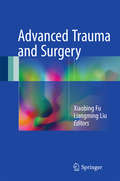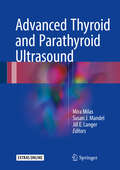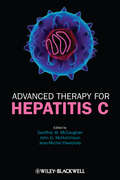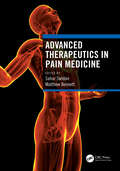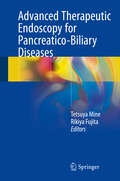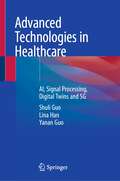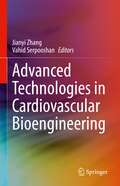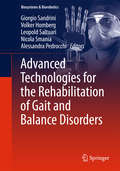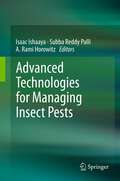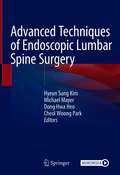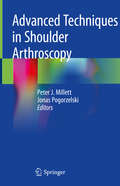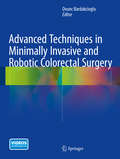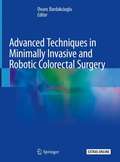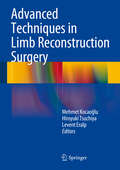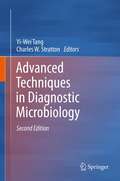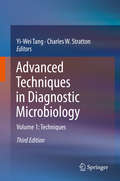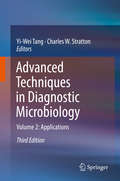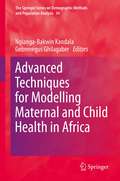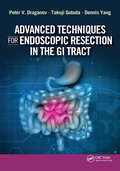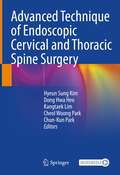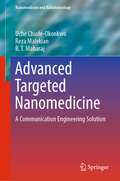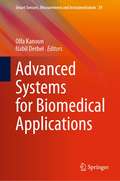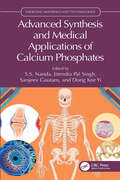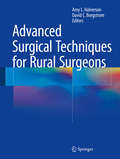- Table View
- List View
Advanced Trauma and Surgery
by Xiaobing Fu Liangming LiuThis book discusses different aspects of trauma surgery, ranging from the various types of trauma and their management, infection, sepsis and inflammation to tissue injury and repair in trauma. It discusses cellular, molecular and genetic research findings and their role in pathogenesis in trauma and injury. In addition, it highlights the translational application of advanced theories and technologies in the management of trauma patients. This book is a valuable resource for anyone involved in the management of severe trauma damage to tissues wanting to reduce early mortality and improve patients' quality of life.
Advanced Thyroid and Parathyroid Ultrasound
by Mira Milas Susan J. Mandel Jill E. LangerThis text provides a comprehensive review of ultrasound in thyroid and parathyroid diseases. These topics are presented from a vantage point of complex decision-making encountered in real clinical scenarios. The sections are organized according to a logical structure covering benign and malignant thyroid conditions, parathyroid disease, and ultrasound technology, ultrasound-guided interventions, and innovations. The style of the chapters provide practical, actionable information that is richly illustrated with figures and links to video cine-clips. The chapter topics aim to show how different specialists uniquely apply ultrasound in given clinical scenarios. The text illustrates the optimal incorporation of current practice guidelines, as this remains varied and inconsistent among clinicians. The content is written by invited experts who perform ultrasound in their daily clinical practices and participate in teaching ultrasound nationally and internationally. It conveys the most up-to-date scientific and clinical information in an interactive and visual format. Advanced Thyroid and Parathyroid Ultrasound fills a gap in currently available resources by serving as a single resource unifying information relevant to multiple specialists interested in advanced thyroid and parathyroid ultrasound. It provides a practical, concise yet comprehensive summary of the current status of the field that will help guide patient management.
Advanced Therapy for Hepatitis C
by Geoffrey W. McCaughanAccording to the WHO, 170 million people, or 3% of the world's population, are infected with Hepatitis C and at risk of developing liver cirrhosis and/or liver cancer. 3-4 million people each year are newly diagnosed carriers of the virus. Advanced Therapy for Hepatitis C Infection provides you with expert guidance from the world’s leading hepatologists on the very latest treatment options for patients with the HCV virus. Focusing mainly on the efficacy and clinical use of antiviral therapies, key topics include: Treatment of recurrent hepatitis C following liver transplantation Antivirals in Cirrhosis and Portal Hypertension HIV and Hepatitis C co-infection Cytopenias: how they limit therapy and potential correction The problem of insulin resistance and its effect on therapy Antivirals in Acute Hepatitis C In addition, it fully covers the foundations for understanding antiviral therapies in HCV, such as the complex pharmacology and mechanisms of antiviral drugs. Finally, a chapter on New Horizons: Interleukin 28 and direct-acting antiviral therapy for HCV, offers you a glimpse into the future possibilities for HCV therapy. Edited by a team of outstanding international reputation, Advanced Therapy for Hepatitis C Infection is an essential tool for all hepatologists and gastroenterologists involved in the management of patients with Hepatitis C.
Advanced Therapeutics in Pain Medicine
by Sahar Swidan and Matthew BennettChronic pain places a tremendous burden on both the patient and the healthcare system. The use of opioids to address pain has resulted in negative impacts. As practitioners work to undo the current opioid crisis, options to manage pain need a new approach. Advanced Therapeutics in Pain Medicine offers pioneering approaches to this intransigent problem providing a functional medicine approach toward treating pain. This book is dedicated to the advancement of non-opioid therapeutic options that offer real progress in reaching a future of better pain management. With an emphasis on pathophysiology, chapters review various types of pain and propose comprehensive treatment plans. These include manual therapies, novel pharmacologic and plant-based approaches, hormonal effects on pain pathways, as well as psychological and lifestyle interventions. Features · Written by a multi-discplinary team, the book provides clinicians with multiple non-opioid treatment considerations. · Enables practitioners to shift from a “one size fits all’ treatment approach toward individualized patient care. · Includes case studies to help educate the provider on how to implement treatment plans in practice. Written by a team of physicians, pharmacists, psychologists and researchers, this important book offers a much needed step forward in optimizing pain care and benefits practitioners who care for patients experiencing chronic pain.
Advanced Therapeutic Endoscopy for Pancreatico-Biliary Diseases
by Tetsuya Mine Rikiya FujitaComprehensively covering various techniques such as ERCP, EUS, EST and lithotripsy, this book highlights innovative endoscopic surgical techniques for managing pancreatico-biliary. It will provide readers an extensive overview of the therapeutic endoscopy management solutions and techniques currently available.Advanced Therapeutic Endoscopy for Pancreatico-Biliary Diseases was written by pioneering experts from around the world, providing a concise yet comprehensive summary of the current state of therapeutic endoscopic techniques in a step-by-step format. Each chapter examines both major and subtle yet important techniques, together with new findings, an approach that will appeal to a broad readership, from beginning to advanced endoscopists and surgeons with a background in gastroenterology, particularly those specializing in endoscopy of pancreatico-biliary diseases to help guide patient management.
Advanced Technologies in Healthcare: AI, Signal Processing, Digital Twins and 5G
by Shuli Guo Lina Han Yanan GuoThis book explores the applications of cutting-edge technologies such as AI, blockchain, signal processing, digital twin technology, and 5G communication technology in healthcare. The writing style combines diagrams, tables, formulae, and text to enhance readability. The content combines theoretical analysis and medical application in every chapter. This book presents several innovative methods, including an AI-based computer-aided diagnosis system, a blockchain-based AI system framework for healthcare, pre-processing algorithms for medical imaging, digital twin models for healthcare, a healthcare platform based on cloud, fog, and edge computing, and a personal health device domain information model. This book will be valuable for researchers, engineers, and post-graduate students in the fields of medicine management and software engineering.
Advanced Technologies in Cardiovascular Bioengineering
by Vahid Serpooshan Jianyi ZhangThis book presents a systematic overview of the technologies currently being explored and utilized in the fields of cardiovascular tissue engineering and regenerative medicine. Considering the unprecedented rapid progress occurring on multiple technological fronts in cardiac tissue engineering, this important new volume fills a need for an up-to-date, comprehensive text on emerging advanced biological and engineering tools. The book is an important resource for anyone looking to understand the emerging topics that have the potential to substantially influence the future of the field. Coverage includes iPS stem cell technologies, nanotechnologies and nanomedicine, advanced biomanufacturing, 3D culture systems, 3D organoid systems, genetic approaches to cardiovascular tissue engineering, and organ on a chip. This book will be a valuable guide for research scientists, students, and clinical researchers in the fields of cardiovascular biology, medicine, and bioengineering, as well as industry-based practitioners working in biomaterial science, nanomaterials and technology, and rapid prototyping and biomanufacturing (3D bioprinting).
Advanced Technologies for the Rehabilitation of Gait and Balance Disorders (Biosystems & Biorobotics #19)
by Giorgio Sandrini Volker Homberg Leopold Saltuari Nicola Smania Alessandra PedrocchiThe book provides readers with a comprehensive overview of the state of the art in the field of gait and balance rehabilitation. It describes technologies and devices together with the requirements and factors to be considered during their application in clinical settings. The book covers physiological and pathophysiological basis of locomotion and posture control, describes integrated approaches for the treatment of neurological diseases and spinal cord injury, as well as important principles for designing appropriate clinical studies. It presents computer and robotic technologies currently used in rehabilitation, such as exoskeleton devices, functional electrical stimulation, virtual reality and many more, highlighting the main advantages and challenges both from the clinical and engineering perspective. Written in an easy-to-understand style, the book is intended for people with different background and expertise, including medical and engineering students, clinicians and physiotherapists, as well as technical developers of rehabilitation systems and their corresponding human-compute interfaces. It aims at fostering an increased awareness of available technologies for balance and gait rehabilitation, as well as a better communication and collaboration between their users and developers.
Advanced Technologies for Managing Insect Pests
by Isaac Ishaaya A. Rami Horowitz Subba Reddy PalliAmong the highlights of this book is the use of novel insecticides acting on a specific site in an insect group and are compatible with natural enemies and the environment. One of such approaches is based on disrupting the activity of biochemical sites acting on transcription factors such as the Helix-Loop-Helix (bHLH) family, anti juvenile hormone (AJH) agents that target JH biosynthetic enzymes, G-protein coupled receptors (GPCR) and bursicon as a target for insect control. Another one is the biotechnology or the genetic approach such as gene silencing (RNA interference) and Bt-crops. Other sections of the book are devoted to the plant's natural products, optical manipulation and the use of nanotechnology for improving insect control methods.
Advanced Techniques of Endoscopic Lumbar Spine Surgery
by Hyeun Sung Kim Michael Mayer Dong Hwa Heo Cheol Woong ParkThis book is a superbly illustrated guide to the latest endoscopic approaches employed in surgery to the lumbar spine. In the past, spinal endoscopic surgeries have been performed mainly in the treatment of lumbar disc herniation, but indications have now expanded owing to breakthroughs in surgical methods and instruments. Furthermore, in addition to the traditional percutaneous transforaminal approach, various other approaches are now feasible, including the posterior, paraspinal, transpedicular, and contralateral. This book describes and illustrates the full array of approaches in indications including lumbar central stenosis, lumbar foraminal stenosis, and lumbar disc herniation. Detailed guidance is also provided on endoscopic lumbar interbody fusion, covering the oblique, uniportal, and biportal approaches. Supplementary surgical videos further facilitate understanding and execution of the described procedures. Written by expert spinal endoscopy surgeons with extensive practical experience and a record of academic achievement, the book will be an ideal aid for spine surgeons at all levels of experience.
Advanced Techniques in Shoulder Arthroscopy
by Peter J. Millett Jonas PogorzelskiThis book is written for the benefit of all surgeons who have an interest in arthroscopic shoulder surgery. It is a compendium of different aspects of shoulder surgery that have been learned over the last 25 years. While there has been a rapid progression of shoulder surgery over the last two decades, particularly with the advancement of operative arthroscopic surgery, certain principles remain. The purpose of this book is not to be an exhaustive detailed account of the various historical aspects of arthroscopic shoulder surgery, but rather to act as an up-to-date, instructional handbook that outlines these principles. The book also helps the practicing shoulder surgeon become familiar some of the latest techniques in arthroscopic shoulder surgery, demonstrating proven approaches and outlining key aspects of common and uncommon procedures. Each chapter starts with the indications for the procedure, moves towards the appropriate evaluation and diagnostic work up, and culminates in specific technical explanation of the surgical procedure itself.Advanced Techniques in Shoulder Arthroscopy is a valuable resource for those who are new to arthroscopic shoulder surgery and for those who are skilled and experienced in operative arthroscopy. It is meant to provide a foundation for basic and advanced arthroscopic techniques that helps surgeons improve their craft and treat their patients better.
Advanced Techniques in Minimally Invasive and Robotic Colorectal Surgery
by Ovunc BardakciogluLaparoscopic colectomy has been introduced in the early 90ies as a new technique with proven improvement in short and long term outcome. Despite significant patient benefits the overall adoption rate remains low. On the other hand significant more advanced techniques such as single incision laparoscopy, robotics and transanal access surgery have been introduced in the last several years and are rapidly evolving. Therefore a significant gap between the practicing community surgeon and innovator seems to exist. Advanced Techniques in Minimally Invasive and Robotic Colorectal Surgery bridges that gap and provides a foundation summarizing and organizing all classic and new techniques in minimally invasive colorectal surgery available in literature and from masters within the field. It provides tips and tricks that allow the user to move up the learning curve, manage difficult scenarios, overcome challenges, increase the utilization of minimal invasive techniques and decrease the conversion to open surgery. By enhancing the surgical tool box the surgeon will be able to progress from the novice to the master. Rather than describing operative procedures which may be very biased by an individual author, the guide provides alternative building blocks of various difficulty for different procedures which can be then tailored to the patient and surgeon`s own comfort level and experience. Advanced Techniques in Minimally Invasive and Robotic Colorectal Surgery will serve as a inspirational guide for the innovator of the future. It will allow surgeons of all levels to better adapt to inevitable changes in future techniques and will be of great value to general surgeons, colon and rectal surgeons, minimally invasive surgeons as well as residents and fellows.
Advanced Techniques in Minimally Invasive and Robotic Colorectal Surgery
by Ovunc BardakciogluThe first edition laid out the foundation with laparoscopic and robotic surgery utilizing the Da Vinci SI platform. Since then, many new advances in equipment and surgical techniques are becoming more popular. This second edition expands upon laparoscopic and endoscopic techniques and robotic surgery with the use of the new Da Vinci XI platform.This book bridges the gap between the practicing community of surgeons and the surgical innovators and provides a foundation for all classic and new techniques in minimally invasive colorectal surgery. By enhancing the surgical toolbox, the surgeon is able to progress from the novice to the master. Rather than describing the entire operative procedure by an individual author, this book compares operative steps of various technical difficulties throughout different chapters, thereby allowing the surgeon to tailor surgery to patient and surgeon`s own comfort level and experience. Chapters are written by a myriad of renowned experts in the field and discuss the major advances in advanced laparoscopic and endoscopic, robotic, and transanal minimally invasive surgical techniques. Great emphasis is placed on transanal total mesorectal excision (TaTME), which is dramatically changing the surgical approach to rectal resections. The second edition of Advanced Techniques in Minimally Invasive and Robotic Colorectal Surgery serves as a valuable resource to general surgeons, colon and rectal surgeons, minimally invasive surgeons, as well as residents and fellows.
Advanced Techniques in Limb Reconstruction Surgery
by Mehmet Kocaoğlu Hiroyuki Tsuchiya Levent EralpAs a result of recent advances in surgical techniques and implant technology it is now possible to perform limb reconstruction in patients with a range of congenital, posttraumatic, and postinfection pathologies. This book is a clear, practical guide to the state-of-the-art surgical procedures employed in limb reconstruction for diverse conditions. It includes precise descriptions of the techniques themselves, accompanied by numerous helpful drawings and photographs. Pearls and pitfalls are highlighted, and thorough advice is also provided on indications, preoperative planning, and postoperative follow-up. The editors have carefully selected the contributors based on their expertise, and many of the authors were themselves responsible for developing the techniques that they describe.
Advanced Techniques in Diagnostic Microbiology
by Charles W. Stratton Yi-Wei TangIn the United States, hospitals annually report over 5 million cases of infectious-disease-related illnesses: clinical microbiology laboratories in these hospitals are engaged in detecting and identifying the pathogenic microorganisms in clinical specimens collected from these patients with suspected infections. Clearly, the timely and accurate detection/identification of these microbial pathogens is critical for patient treatment decisions and outcomes for millions of patients each year. Despite an appreciation that the outcome of an infectious-disease-related illness is directly related to the time required to detect and identify a microbial pathogen, clinical microbiology laboratories in the United States as well as worldwide have long been hampered by traditional culture-based assays, which may require prolonged incubation time for slowly growing microorganisms such as Mycobacterium tuberculosis. Moreover, traditional culture-based assays often require multiple steps with additional time needed for discernment of species and/or detection of antimicrobial resistance. Finally, these traditional, slow multistep culture-based assays are labor-intensive and required skilled clinical microbiologists at the bench. Over the past several decades, advanced molecular techniques in diagnostic microbiology quietly have been revolutionizing the practice of clinical microbiology in the hospital setting. Indeed, molecular diagnostic testing in general and nucleic-acid-based amplification methods in particular have been heralded as diagnostic tools for the new millennium. There is no question that the development of rapid molecular techniques for nucleic acid amplification/characterization combined with automation and user-friendly software has greatly broadened the diagnostic capabilities of the clinical microbiology laboratory. These technical advances in molecular microbiology over the first decade of the 21st Century have profoundly influenced the physical structure of clinical microbiology laboratories as well as their staffing patterns, workflow, and turnaround time. These molecular microbiology advances have also resulted in the need for a revised and updated second edition of Advanced Techniques in Diagnostic Microbiology. This second edition again provides an updated and comprehensive description of the ongoing evolution of molecular methods for the diagnosis of infectious diseases. In addition, many new chapters have been added, including a chapter on the clinical interpretation and relevance of advanced technique results. The second edition, like the first edition, includes both a "techniques" section describing the latest molecular techniques and an "applications" section describing how these advanced molecular techniques are being used in the clinical setting. Finally, the second edition, like the first edition, utilizes a diverse team of authors who have compiled chapters that provide the reader with comprehensive and useable information on advanced molecular microbiology techniques.
Advanced Techniques in Diagnostic Microbiology: Volume 1: Techniques
by Yi-Wei Tang Charles W. StrattonIn recent years, advanced molecular techniques in diagnostic microbiology have been revolutionizing the practice of clinical microbiology in the hospital setting. Molecular diagnostic testing in general and nucleic acid-based amplification methods in particular have been heralded as diagnostic tools for the new millennium. This third edition covers not only the most recent updates and advances, but details newly invented omic techniques, such as next generation sequencing. It is divided into two distinct volumes, with Volume 1 describing the techniques, and Volume 2 addressing their applications in the field. In addition, both volumes focus more so on the clinical relevance of the test results generated by these techniques than previous editions.
Advanced Techniques in Diagnostic Microbiology: Volume 2: Applications
by Yi-Wei Tang Charles W. StrattonIn recent years, advanced molecular techniques in diagnostic microbiology have been revolutionizing the practice of clinical microbiology in the hospital setting. Molecular diagnostic testing in general and nucleic acid-based amplification methods in particular have been heralded as diagnostic tools for the new millennium. This third edition covers not only the most recent updates and advances, but details newly invented omic techniques, such as next generation sequencing. It is divided into two distinct volumes, with Volume 1 describing the techniques, and Volume 2 addressing their applications in the field. In addition, both volumes focus more so on the clinical relevance of the test results generated by these techniques than previous editions.
Advanced Techniques for Modelling Maternal and Child Health in Africa (The Springer Series on Demographic Methods and Population Analysis #34)
by Gebrenegus Ghilagaber Ngianga-Bakwin KandalaThis book presents both theoretical contributions and empirical applications of advanced statistical techniques including geo-additive models that link individual measures with area variables to account for spatial correlation; multilevel models that address the issue of clustering within family and household; multi-process models that account for interdependencies over life-course events and non-random utilization of health services; and flexible parametric alternatives to existing intensity models. These analytical techniques are illustrated mainly through modeling maternal and child health in the African context, using data from demographic and health surveys. In the past, the estimation of levels, trends and differentials in demographic and health outcomes in developing countries was heavily reliant on indirect methods that were devised to suit limited or deficient data. In recent decades, world-wide surveys like the World Fertility Survey and its successor, the Demographic and Health Survey have played an important role in filling the gap in survey data from developing countries. Such modern demographic and health surveys enable investigators to make in-depth analyses that guide policy intervention strategies, and such analyses require the modern and advanced statistical techniques covered in this book. The text is ideally suited for academics, professionals, and decision makers in the social and health sciences, as well as others with an interest in statistical modelling, demographic and health surveys. Scientists and students in applied statistics, epidemiology, medicine, social and behavioural sciences will find it of value.
Advanced Techniques for Endoscopic Resection in the GI Tract
by Dennis Yang Peter Draganov Takuji GotodaSurgery has traditionally been the standard of care for the treatment of neoplastic lesions in the gastrointestinal tract. With advances in endoscopic resection techniques, there has been a paradigm shift in how to approach many of these precancerous and early cancerous lesions. Potential advantages of endoscopic resection include its minimally invasiveness which often translates into quicker patient recovery. In recent years, there have been major strides in safety and efficacy of minimally invasive endoscopic approaches with ongoing advances in therapeutic endoscopy. Advanced Techniques for Endoscopic Resection in the GI Tract by Drs. Peter V. Draganov, Takuji Gotoda, and Dennis J. Yang provides an in-depth analysis of the current state of advanced endoscopic techniques for the evaluation and resection in the gastrointestinal tract. Each chapter in the book addresses specific topics such as: endoscopic evaluation of lesions technical aspects of the procedure management of adverse events post-procedural care and follow-up Advanced Techniques for Endoscopic Resection in the GI Tract provides a comprehensive review of all the different aspects of advanced endoscopic resection in the gastrointestinal tract which makes it ideal for interventional GI endoscopists and general gastroenterologists, as well as surgeons.
Advanced Technique of Endoscopic Cervical and Thoracic Spine Surgery
by Hyeun Sung Kim Dong Hwa Heo Kangtaek Lim Cheol Woong Park Chun-Kun ParkIn the past, the cervical and thoracic vertebrae were areas that were not well performed by spinal endoscopy. However, with the rapid development of spinal endoscopic surgery techniques and instruments, various kinds of spinal endoscopic approaches are currently performing and developing in the cervical and thoracic spine. This is the first book covering the latest knowledge of cervical and thoracic spinal endoscopic surgery.This book will provide abundant illustrations and also surgical videos so that it can be easily understood by spinal surgeons who are learning and studying spinal endoscopy. In addition, the prevention of complications associated with endoscopic surgery will be discussed in detail.
Advanced Targeted Nanomedicine: A Communication Engineering Solution (Nanomedicine And Nanotoxicology)
by Uche Chude-Okonkwo Reza Malekian B. T. MaharajThis book presents medical challenges as communication engineering problems. It offers the reader the interesting perspective of exploring and understanding disease pathology from the point of view of communication engineers. Therefore, diseases and their treatments can be addressed using conventional communication paradigms, approaches, tools and devices; thereby ushering in the interdisciplinary research platform termed advanced targeted nanomedicine. The rudimentary framework for advanced targeted nanomedicine is presented and expatiated across the seven chapters of this book.
Advanced Systems for Biomedical Applications
by Olfa Kanoun Nabil DerbelAdvanced Systems for Biomedical Applications
Advanced Systems for Biomedical Applications (Smart Sensors, Measurement and Instrumentation #39)
by Olfa Kanoun Nabil DerbelThe book highlights recent developments in the field of biomedical systems covering a wide range of technological aspects, methods, systems and instrumentation techniques for diagnosis, monitoring, treatment, and assistance. Biomedical systems are becoming increasingly important in medicine and in special areas of application such as supporting people with disabilities and under pandemic conditions. They provide a solid basis for supporting people and improving their health care. As such, the book offers a key reference guide about novel medical systems for students, engineers, designers, and technicians.
Advanced Synthesis and Medical Applications of Calcium Phosphates (Emerging Materials and Technologies)
by S. S. Nanda Jitendra Pal Singh Sanjeev Gautam Dong Kee YiCalcium phosphate materials are used in many medical and dental applications. Advanced Synthesis and Medical Applications of Calcium Phosphates covers the structure, chemistry, synthesis, and properties of both natural and synthetic calcium-based biomaterials and details a variety of medical applications. Depicts the latest advances in using calcium phosphates in bone regeneration and tissue engineering Includes the latest generation of regenerative biomaterials with an integrated perspective combining both research and clinical issues Provides an understanding of the clinical targets and requirements for regenerative medicine Detailing fundamentals through applications, this book helps biomaterials researchers to better understand the clinical targets and requirements for use of these materials for optimal synthesis and development.
Advanced Surgical Techniques for Rural Surgeons
by David C. Borgstrom Amy L. HalversonThis unique reference fulfills the unmet need of a textbook that addresses the scope of practice for surgeons practicing in rural regions. The text provides up-to-date content covering a wide breadth of topics relevant to surgical care in rural areas, with focus on the surgical diseases that are often treated by surgical subspecialists in the urban setting. Written by experts in each subspecialty, the text focuses on procedural aspects of surgical patient care. The first section discusses practice issues unique to rural surgery and provides an overview of applying principles of quality improvement to surgical practice. Subsequent chapters cover specific surgical procedures. Each chapter includes a brief discussion of indications and contraindications for surgery. The surgical technique is described with attention to important anatomic details. Key portions of the procedure are highlighted including potential complications and how to avoid them. Procedure specific perioperative care is also discussed. Supported with ample illustrations and images, Advanced Surgical Techniques for Rural Surgeons is a valuable resource for surgeons currently in practice or preparing to practice in a rural area, as well as surgical technicians, surgical nurse practitioners and physician's assistants.
